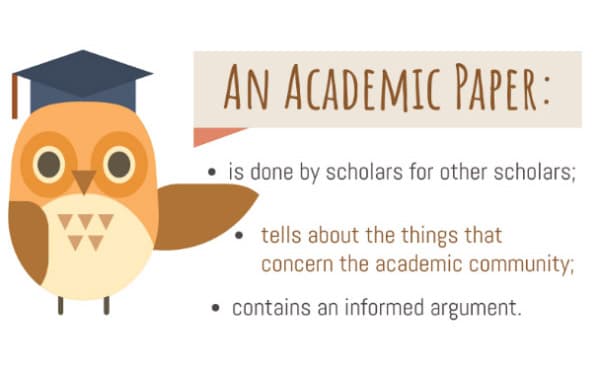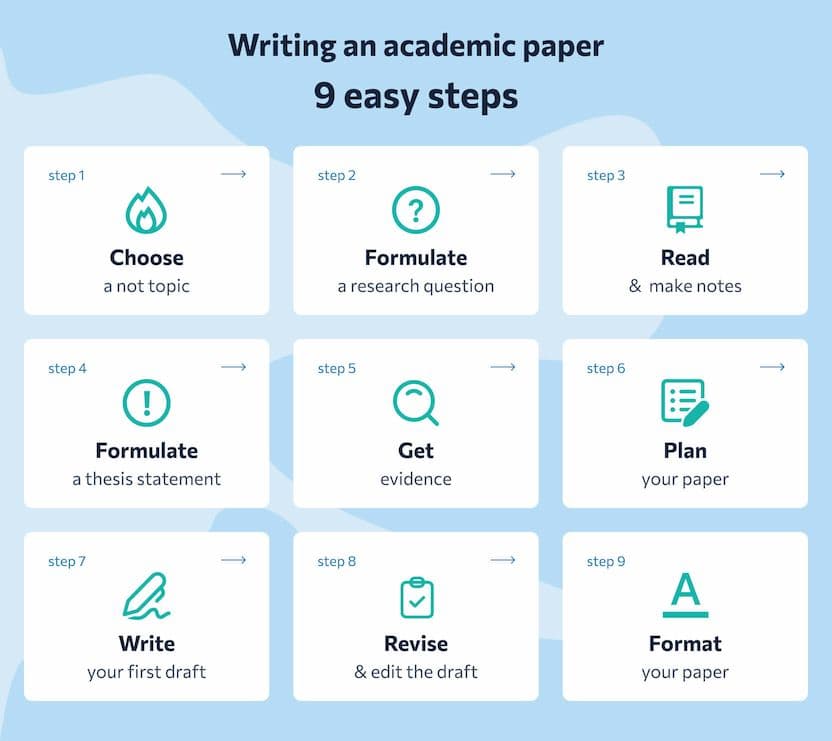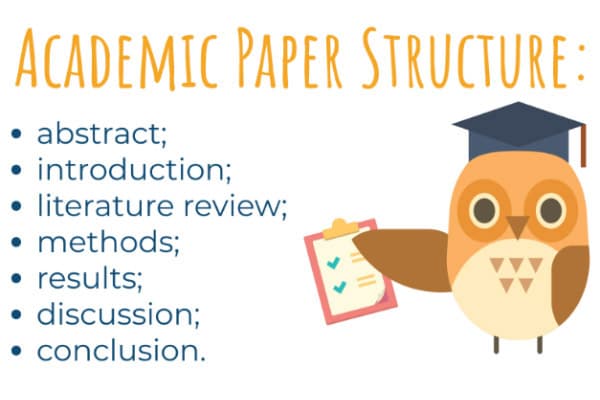Academic Paper Examples
📜 What Is an Academic Paper?
There are many forms of academic writing, but an academic paper should always meet three basic criteria. It should be written by scholars for other scholars, focus on issues that concern the academic community, and contain an informed argument. Other characteristics of academic writing include a formal writing style, specific vocabulary terms, and the use of the third-person perspective.

📝 Types of Academic Papers
There are four general types of academic texts. A descriptive text describes a phenomenon, person, or fact. A reflective text conveys the author’s response to experiences, opinions, or new information. An analytical paper shows the relationships between different phenomena. And, finally, a critical text evaluates someone else’s work.
Examples of academic paper genres include:
- Book reviews
- Critique papers
- Essays
- Movie analysis
- Reports
- Research papers
- etc.
📚 Book Review
To put it simply, a review is a critical evaluation of a text, object, event, etc. A review is not merely a summary, but rather a commentary with persuasive arguments. When writing a good book review, you need to clearly state your opinion of the work in question, and support your statements logically and/or empirically.
Reviews are usually short and rarely exceed 1000 words in academic journals and newspapers. The structure of a book review often resembles that of other academic papers, featuring typical elements like an introduction, a thesis statement, body paragraphs, and a conclusion.
🤨 Critique Paper
A critique paper aims to critically read and analyze a text, research, or performance. It can also be called a response paper. A critique resembles a book review, but there are important differences. A review should contain the key points of the work in question, while a critique focuses on the evaluation and analysis of the text or research.
If you need more information on how to write a critique paper, take a look at our killer writing tips!
✍️ Academic Essay
An essay is a common form of academic writing. Many different kinds of academic essays exist, but most of them share the same goal of informing readers about the author’s position with the help of arguments and evidence.
There is no ready-made formula for the perfect essay structure.
Instead, it may be useful to think of the different sections of the text as answers to different questions that your reader might have when encountering your research essay. For example, “What” is probably the first question a reader might have. Thus, the “what” or “demonstration” section of your paper, which aims to explain the phenomenon about which you are writing, should come early, just after the introduction.
Next, your reader might want to know if the claims you make are valid in all cases. “How” is the corresponding question here. How will another perspective, a new set of materials, or different sources affect the claim you make? A typical academic essay usually contains at least one “how” section.
And finally, before coming to a conclusion, your reader might want to ask “Why” or “So what”. Why does this matter to anyone besides you? Answering this question helps your readers understand the text within a broader context. By providing a clear response to the "why" question, your essay demonstrates its significance.
🎥 Movie Analysis
Unlike literature, a movie includes audiovisual elements. However, literature and film do have many similarities. Both use characters, dialogues, plots, settings, symbolism, etc. These features can be analyzed for their intent and effect in both cinema and literature.
Coherent arguments and convincing evidence are as crucial for movie analysis as for other scholarly papers. Therefore, well-developed academic writing skills are required to write a successful film analysis paper.
📊 Academic Report
A report is a type of academic paper that is created for a very clear purpose and contains specific information and evidence. Students are usually asked to write reports for one of two reasons: 1) to demonstrate what they have learned, or 2) to develop an important skill. Moreover, a good report needs to be clear, concise, and well structured. Still confused about writing a report? Don’t hesitate to check out our report writing tips!
🔬 Research Paper
Like most other scholarly papers, an academic research paper is not just a collection of information or a review of the literature on a particular topic. A research paper needs to present your own argument on a topic, supported by others’ works.
What does a research paper look like? Usually, it is an expanded version of an essay. When working on an essay, a student often focuses on personal thoughts and experiences. However, to write on a research paper, you need to find out what the experts know. Thus, a literature review section is usually an essential part of a research paper outline. Other important parts include the abstract, introduction, methods, results, discussion, and references.
How long should a research paper be? There’s no single answer to this question because the length of a research paper depends on its topic and purpose. However, an average paper usually fills between four and five pages.
If you need more advice on how to do a research paper, please read this article!
👣 How to Write an Academic Paper: 9 Easy Steps
The whole writing process may seem overly complex and intimidating at first. But when you break it down into smaller tasks, it becomes more organized and manageable.
Below is a step-by-step guide on how to write an academic paper most efficiently. Before jumping into it, you can add a preparation stage. Spend a little bit of time by checking out some free essay samples to gain some inspiration and generate ideas. It will boost the whole process and help you reach your goal with ease.

🔥 Step 1. Choose a Hot Topic
Selecting a topic is probably the most difficult challenge for students who are starting their research papers. Sometimes you are assigned a topic, but often you need to choose one by yourself. Choosing and defining a good topic is a crucial part of a successful research project. However, don’t fret about coming up with the final version for the header of your academic paper at this stage. That decision comes much later.
❓ Step 2. Formulate Your Topic as a Research Question
A research question is the base of every scholarly paper. You can think of your research project as a house. The data collection forms the walls, and the hypothesis is the foundation. Your research question, however, is even more fundamental; it is the ground beneath the house. It needs to be solid, specific, and answerable.
At this stage, it is important to develop a preliminary research question, keeping in mind that you’ll probably refine or even change it later.
🤓 Step 3. Read & Make Notes
Most likely, you’ll have reviewed some sources by this stage of topic selection, but now is the time to dig deeper.
To get started, make a list of the sources that you plan to use. Ideally, they should be relevant to the topic and as current as possible. Make sure that you understand who the top voices in your field are and what they have to say about your topic. If you have any questions, you can always use our guide on how to find credible sources.
It is a good idea to take notes while reading. Later, you’ll be able to convert them into a full literature review section.
❗ Step 4. Formulate a Thesis Statement
Once you’ve decided on a research question, and you have a grasp on what other scholars have written on the topic, it is time to make your own ideas more concrete. At this stage, you need to formulate a thesis statement that aims to convey the central argument of your academic paper. Your task is to persuade your audience that you have something valuable to say. A good thesis statement should be specific, debatable, and concise.
🔍 Step 5. Get Your Empirical Results
This step is not always necessary. Still, if you need empirical evidence to prove your thesis, you’ll have to spend time collecting it. Scholars conduct their research in different ways, so this stage is flexible according to your specific topic. If you have any questions about gathering empirical evidence, you can always consult your professor.
📅 Step 6. Plan Your Paper
The work that you’ve already done has probably given you tons of exciting ideas. Your task at this stage is to organize these ideas logically in an outline format. Think of the key points that support your thesis and use them as subheadings for the body paragraphs of your paper.
A typical academic paper structure includes:
- an abstract
- an introduction
- a literature review
- a methods section
- a results section
- a discussion
- a conclusion

🖊️ Step 7. Write Your Draft
At this stage, you already have an outline that gives you a direction. All you need to do is create the first draft of your paper by filling in the details of each section.
The header of your academic paper is very important. If you want to make a good impression on your audience, take note that the title is the first thing that they’ll see. Make a list of the keywords that pertain to the topic you chose, the methods you used, and the results you obtained. Create a sentence that includes as many of the keywords as possible. Make it logical and concise, and add a subtitle if needed.
After creating your headers, you’ll find that drafting the individual sections of your paper is much easier. If you still have doubts, you can find more information on how to write an academic paper here.
🗒️ Step 8. Revise & Edit the Draft
Now that you’ve managed to finish your first draft, take a moment to congratulate yourself! And then, get back to work because you still have a lot to do.
Remember, the first draft is never perfect. If you want to make a good impression on your audience, revise and edit the content and grammar of your paper. Use our checklists to make your academic paper as perfect as it can be.
🔤 Step 9. Format Your Paper
At this stage, you need to make sure that that the format of your academic paper meets the correct style requirements. Pay special attention to citations.
The idea behind citations is simple. If you use the ideas of other people in your work, you must give them credit.
How do you cite your sources? There are many citation styles, but the most popular are APA and MLA.
What is APA Format?
APA (American Psychological Association) style is often used in Social Sciences (Sociology, Anthropology, Economics, etc.), but many other disciplines use it too.
Take a look at our guidelines if you need to write a paper that requires APA format. You can also find sample APA papers below.
What is MLA Format?
MLA style was developed by the Modern Language Association. MLA is the leading style of documentation in the Humanities, and enables students and researchers in the fields of Language and Literature to format their papers in a universal way.
Want to learn more? You can always read our guidebook, or find sample MLA papers below.
❓ Academic Paper FAQs
To write a paper, you need to choose a hot topic and formulate a research question. Then read your sources and get some empirical evidence if necessary. Then make a plan of your paper and write the first draft of it. Take your time to revise and edit the draft. And, finally, don’t forget about the formatting!
Selecting a research topic is the starting point for every paper. It is also probably the most difficult challenge, especially when you need to choose one by yourself. However, don’t worry too much about coming up with the final version of the topic at this stage. Formulate a preliminary one. Once you’ve formulated a topic and a research question, the base of your scientific paper is ready.
A good academic paper features several characteristics. First of all, it has a clear purpose. It contains a research question and an answer to it. Moreover, a good paper presents an original point of view. A good academic text is a well-structured one: all parts of it should support the thesis statement. The explanations should be clear, logical, and straightforward. Last but not least, a good paper bases on a number of scholarly sources.
A basic academic paper structure includes three main parts: an introduction, a body, and a conclusion. The body is usually the most voluminous part of any paper. It typically consists of a literature review, a methods section, results, and discussion. An abstract (a short and concise summation of the entire story) is not always required. Still, most academic papers aimed for publication have one.
Numerous forms of academic writing exist. Still, an excellent example of academic writing should be written by scholars for other scholars, explore the issues that concern the academic community, and contain an informed argument. Examples of academic writing include book reviews, critique papers, essays, movie analysis, reports, research papers, etc.
References
- What is an Academic Paper? University of Washington
- Film Analysis: UNC Writing Center
- How to Write an Academic Report: Middlesex University
- How to Select a Research Topic: UMFlint
- How to Write a Research Question: GMU Writing Center
- A guide to writing an academic paper: The Washington Post
- Writing a Literature Review: Ashford University Writing Center
- Literature Reviews: UNC Writing Center